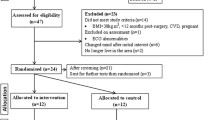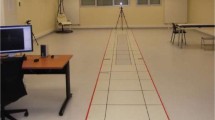Abstract
Background
This study examined relationships between excess body weight (EBW) loss and current gait and functional status in women 5 years after Roux-en-Y gastric bypass surgery.
Methods
Gait data were analyzed in nine female bariatric patients for relationships with longitudinal changes in weight, body composition, and physical function assessed by the Short Musculoskeletal Functional Assessment (SMFA) questionnaire and the timed “get-up-and-go” (TGUG) test. Gait characteristics in the bariatric sample were also compared to an age- and BMI-matched nonsurgical reference sample from the Fels Longitudinal Study.
Results
Bariatric patients lost an average of 36.4 kg (61.1 %) of EBW between preoperative and 5-year follow-up visits (P < 0.01); SMFA function index scores and TGUG times also decreased (both P < 0.01). Degree of EBW loss was correlated with less time spent in initial double support and more time in single support (both P = 0.02), and for all gait variables, the bariatric sample fell within the 95 % confidence intervals of gait/EBW relationships in the reference sample.
Conclusions
Gait and function 5 years after bariatric surgery were characteristic of current weight, not preoperative obesity, suggesting that substantial, sustained recovery of physical function is possible with rapid surgical weight loss.



Similar content being viewed by others
References
Vincent HK, Vincent KR, Lamb KM. Obesity and mobility disability in the older adult. Obes Rev. 2010;11(8):568–79.
Browning RC, Kram R. Effects of obesity on the biomechanics of walking at different speeds. Med Sci Sports Exerc. 2007;39(9):1632–41.
Ferraro KF, Booth TL. Age, body mass index, and functional illness. J Gerontol Ser B Psychol Sci Soc Sci. 1999;54(6):S339–48.
Vincent HK, Ben-David K, Conrad BP, et al. Rapid changes in gait, musculoskeletal pain, and quality of life after bariatric surgery. Surg Obes Relat Dis. 2012;8(3):346–54.
Fontaine KR, Barofsky I. Obesity and health-related quality of life. Obes Rev. 2001;2(3):173–82.
World Health Organization. Obesity: preventing and managing the global epidemic—introduction. Obesity: preventing and managing the global epidemic. 2000;894:1–253.
Hergenroeder AL, Brach JS, Otto AD, et al. The influence of body mass index on self-report and performance-based measures of physical function in adult women. Cardiopulm Phys Ther J. 2011;22(3):11–20.
Villareal DT, Apovian CM, Kushner RF, et al. Obesity in older adults: technical review and position statement of the American Society for Nutrition and NAASO. The Obesity Society. Obes Res. 2005;13(11):1849–63.
Buchwald H, Avidor Y, Braunwald E, et al. Bariatric surgery: a systematic review and meta-analysis. JAMA. 2004;292(14):1724–37.
Iossi MF, Konstantakos EK, Teel DD, et al. Musculoskeletal function following bariatric surgery. Obesity. 2013;21(6):1104–10.
Elder KA, Wolfe BM. Bariatric surgery: a review of procedures and outcomes. Gastroenterology. 2007;132(6):2253–71.
Gilbert EW, Wolfe BM. Bariatric surgery for the management of obesity: state of the field. Plast Reconstr Surg. 2012;130(4):948–54.
Schauer PR, Ikramuddin S, Gourash W, et al. Outcomes after laparoscopic Roux-en-Y gastric bypass for morbid obesity. Ann Surg. 2000;232(4):515–26.
Needleman BJ, Happel LC. Bariatric surgery: choosing the optimal procedure. Surg Clin N Am. 2008;88(5):991–1007.
Silver HJ, Torquati A, Jensen GL, et al. Weight, dietary and physical activity behaviors two years after gastric bypass. Obes Surg. 2006;16(7):859–64.
Miller GD, Nicklas BJ, You T, et al. Physical function improvements after laparoscopic Roux-en-Y gastric bypass surgery. Surg Obes Relat Dis. 2009;5(5):530–7.
Hortobagyi T, Herring C, Pories WJ, et al. Massive weight loss-induced mechanical plasticity in obese gait. J Appl Physiol. 2011;111(5):1391–9.
Vartiainen P, Bragge T, Lyytinen T, et al. Kinematic and kinetic changes in obese gait in bariatric surgery-induced weight loss. J Biomech. 2012;45(10):1769–74.
Higa K, Ho TC, Tercero F, et al. Laparoscopic Roux-en-Y gastric bypass: 10-year follow-up. Surg Obes Relat Dis. 2011;7(4):516–25.
Roche AF. Growth, maturation and body composition: the Fels longitudinal study 1929–1991. Cambridge: Cambridge University Press; 1992. 282 p.
Kovacs CR. Age-related changes in gait and obstacle avoidance capabilities in older adults: a review. J Appl Gerontol. 2005;24(1):21–34.
Felson DT. Does excess weight cause osteoarthritis and, if so, why? Ann Rheum Dis. 1996;55(9):668–70.
Runhaar J, Koes BW, Clockaerts S, et al. A systematic review on changed biomechanics of lower extremities in obese individuals: a possible role in development of osteoarthritis. Obes Rev. 2011;12(12):1071–82.
Lohman TG, Roche AF, Martorell R, (Eds.). Anthropometric standardization reference manual. Champaign: Human Kinetics; 1988.vi p.
Lorentz FH. Ein neuer Konstitionsinde. Klin Wochenschr. 1929;8:348–51.
Swiontkowski MF, Engelberg R, Martin DP, et al. Short musculoskeletal function assessment questionnaire: validity, reliability, and responsiveness. J Bone Joint Surg Am. 1999;81(9):1245–60.
Podsiadlo D, Richardson S. The timed “Up & Go”: a test of basic functional mobility for frail elderly persons. J Am Geriatr Soc. 1991;39(2):142–8.
Freter SH, Fruchter N. Relationship between timed ‘up and go’ and gait time in an elderly orthopaedic rehabilitation population. Clin Rehabil. 2000;14(1):96–101.
Kadaba MP, Ramakrishnan HK, Wootten ME, et al. Repeatability of kinematic, kinetic, and electromyographic data in normal adult gait. J Orthop Res. 1989;7(6):849–60.
Hof AL. Letter to the editor: scaling gait data to body size. Gait Posture. 1996;4:222–3.
Froehle AW, Nahhas RW, Sherwood RJ, et al. Age-related changes in spatiotemporal characteristics of gait accompany ongoing lower limb linear growth in late childhood and early adolescence. Gait Posture. 2013;38(1):14–9.
de Souza SAF, Faintuch J, Valezi AC, et al. Gait cinematic analysis in morbidly obese patients. Obes Surg. 2005;15(9):1238–42.
Hergenroeder AL, Wert DM, Hile ES, et al. Association of body mass index with self-report and performance-based measures of balance and mobility. Phys Ther. 2011;91(8):1223–34.
O’Brien PE, McPhail T, Chaston TB, et al. Systematic review of medium-term weight loss after bariatric operations. Obes Surg. 2006;16(8):1032–40.
Bohannon RW. Reference values for the timed up and go test: a descriptive meta-analysis. J Geriatr Phys Ther. 2006;29(2):64–8.
Wall JC, Bell C, Campbell S, et al. The timed get-up-and-go test revisited: measurement of the component tasks. J Rehabil Res Dev. 2000;37(1):109–13.
Acknowledgments
The authors thank the participants. The study was funded by a grant from the Department of Community Health, Wright State University Boonshoft School of Medicine.
Conflict of Interest
None of the authors declare any conflict of interest.
Author information
Authors and Affiliations
Corresponding author
Rights and permissions
About this article
Cite this article
Froehle, A.W., Laughlin, R.T., Teel, D.D. et al. Excess Body Weight Loss is Associated with Nonpathological Gait Patterns in Women 4 to 5 Years After Bariatric Surgery. OBES SURG 24, 253–259 (2014). https://doi.org/10.1007/s11695-013-1069-x
Published:
Issue Date:
DOI: https://doi.org/10.1007/s11695-013-1069-x




